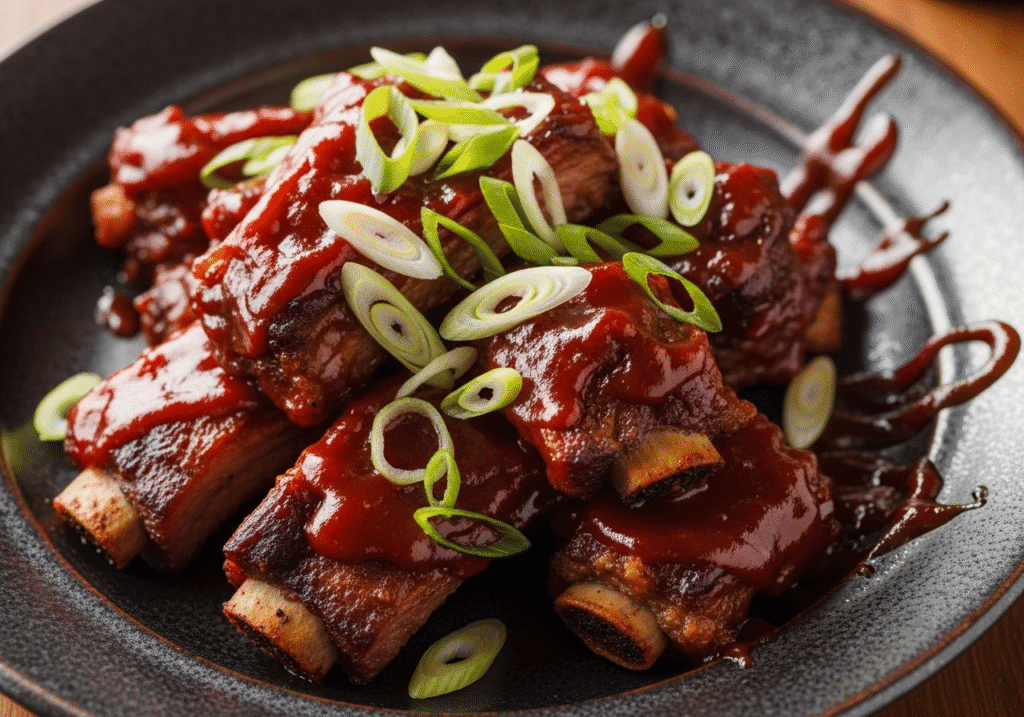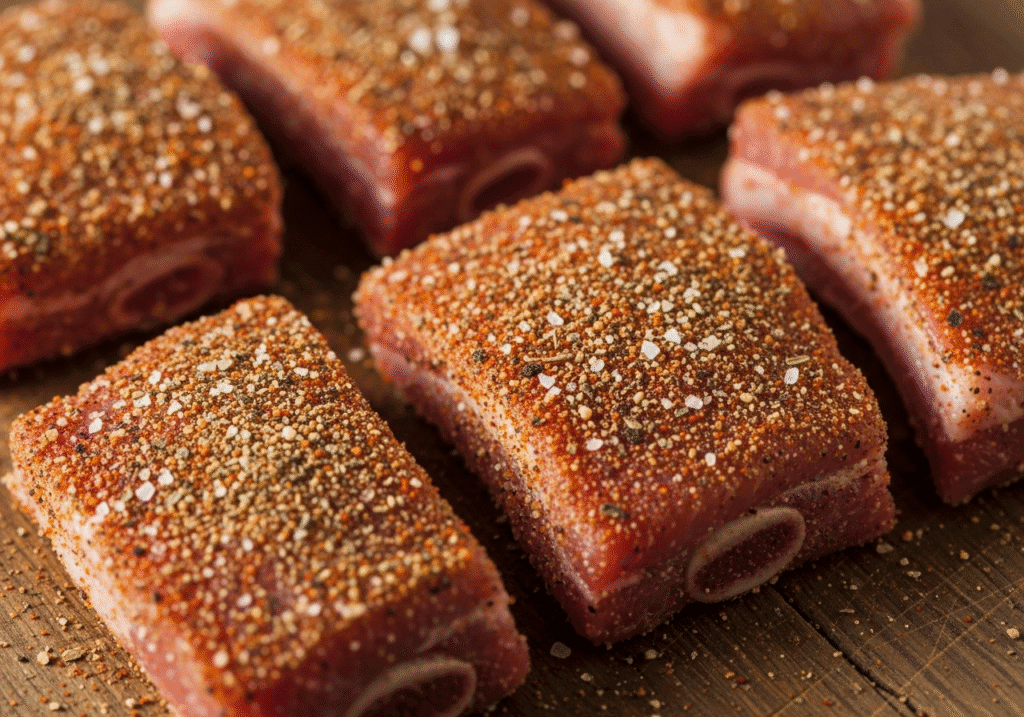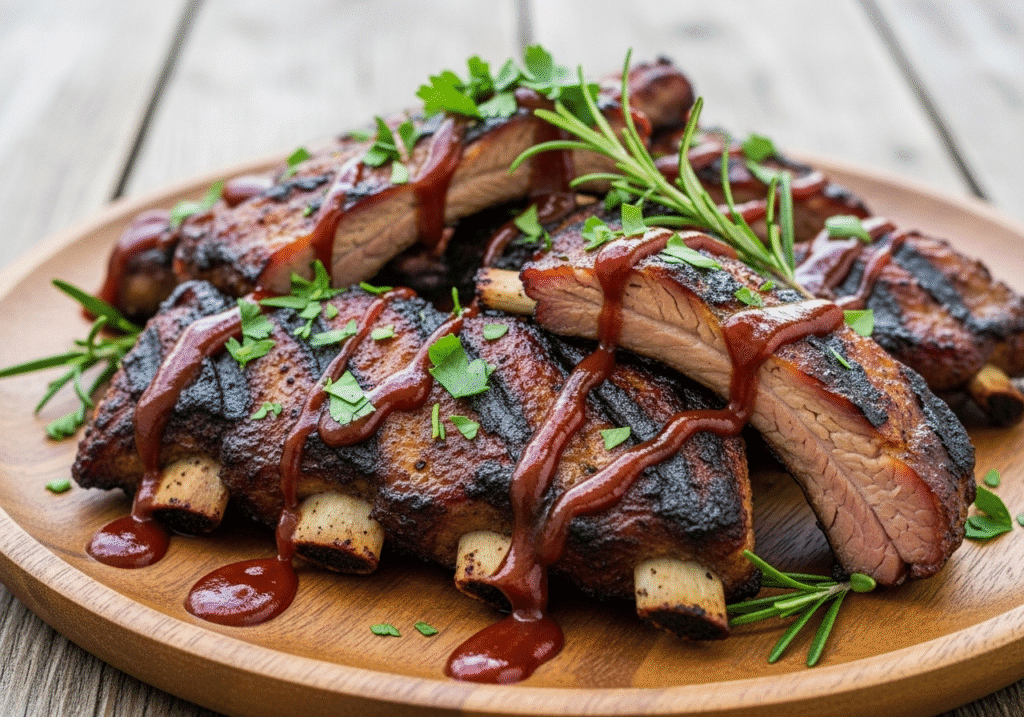10 Irresistible Rib Tips Recipes and How to Cook Rib Tips Perfectly
Rib tips are a flavorful and affordable cut of pork ribs that are gaining popularity among BBQ enthusiasts and home cooks alike. Known for their rich taste and tender texture when cooked right, rib tips offer a delicious alternative to traditional ribs. Whether you prefer grilling rib tips over open flames, slow cooking them to perfection, or trying a savory Chinese rib tips recipe, this guide has you covered. In this article, you’ll discover the best rib tips recipes and learn how to cook rib tips using various methods to ensure juicy, mouthwatering results every time.
Table of Contents
What Are Rib Tips?
Rib tips are the flavorful, irregularly shaped pieces trimmed from the lower end of spare ribs, where the rib bones meet the cartilage near the breastbone. Sometimes called riblets or rib scraps, rib tips differ from baby back ribs and spare ribs in both texture and size. They contain a mix of meat, fat, cartilage, and small bones, which makes them a bit tougher if not cooked properly but also packed with rich flavor.
Because of their higher fat content and connective tissue, rib tips require longer cooking times to break down and become tender. When slow-cooked or grilled low and slow, these cuts transform into juicy, melt-in-your-mouth bites with a perfect balance of chewiness and tenderness. Their irregular shape also makes them ideal for soaking up marinades, rubs, and smoke flavors, making them a favorite among BBQ enthusiasts.
Rib tips are often more affordable than traditional ribs, making them a budget-friendly choice without sacrificing taste. Many pitmasters and home cooks prize rib tips for their intense pork flavor and satisfying texture. Whether you’re grilling rib tips over charcoal or slow cooking them in a crockpot, understanding this cut’s unique characteristics will help you cook them to perfection every time.
Why Rib Tips Are Perfect for Grilling
Rib tips are an excellent choice for grilling because their size and texture absorb smoke and heat beautifully. When you grill rib tips, the high heat helps render the fat slowly, creating juicy meat with a crispy, caramelized exterior. The combination of smoky flavor and the natural richness of rib tips makes grilling one of the best cooking methods to highlight their taste.
Grilling rib tips also allows for great versatility in seasoning and sauces. Whether you prefer a spicy dry rub or a sweet BBQ glaze, the porous texture of rib tips ensures the flavors penetrate deeply. Plus, because rib tips are smaller and irregularly shaped, they cook faster than full racks of ribs, making them a convenient option for backyard BBQs.
Another reason grilling rib tips is so popular is the satisfying bite they offer. The mix of tender meat, flavorful fat, and slightly chewy cartilage gives a unique texture experience that many rib lovers crave. Whether you’re a beginner or a seasoned griller, mastering grilling rib tips will elevate your BBQ game with minimal effort.
How to Cook Rib Tips: Basic Techniques
There are several popular ways to prepare this cut of meat, each bringing out different tastes and textures. The most common approaches include cooking over a grill, using a slow cooker, or baking in the oven.
Cooking on a grill is perfect for those who enjoy smoky, charred flavors. This method involves cooking over direct or indirect heat, often using charcoal or gas. Grilling helps melt the fat and create a crispy, caramelized outer layer while keeping the inside juicy.
Using a slow cooker is great for hands-off preparation. By simmering the meat slowly in a covered pot, the tough connective tissues break down, resulting in tender meat that easily falls apart. This method suits busy cooks who want flavorful results without constant attention.
Baking in the oven provides a controlled environment, allowing the meat to cook slowly with foil coverings or in a covered dish. This helps retain moisture and allows seasonings to soak in evenly.
The best method for you will depend on how much time you have, what equipment is available, and your taste preferences. Coming up, we will explore detailed instructions for grilling and slow cooking with step-by-step guidance.
Grilling Rib Tips: Step-by-Step Guide
Grilling this cut of meat is a fantastic way to bring out its rich flavor while achieving a tender, juicy texture with a slightly crispy outside. Whether you’re new to grilling or have plenty of experience, following these detailed steps will help you get great results every time.
1. Preparing the Meat
Start by trimming any extra fat or the thin silver skin from the pieces. Removing this tough layer helps prevent chewiness and allows seasonings to soak in better. Use a sharp knife carefully so you don’t cut into the meat itself. After trimming, pat the pieces dry with paper towels to help them sear nicely.
2. Seasoning or Marinating
This cut absorbs flavors well, so choose a dry seasoning mix or liquid marinade that suits your preferences. For a classic smoky taste, a blend of brown sugar, smoked paprika, garlic powder, onion powder, salt, and pepper works well. Apply your seasoning generously over all sides, rubbing it in thoroughly. For stronger flavor, marinate the meat in your preferred sauce for several hours or overnight in the fridge. Bring it to room temperature before grilling.
3. Preheating the Grill
Prepare your grill for indirect cooking by setting up two heat zones: one for direct high heat and one for indirect lower heat. Preheat the grill to a moderate temperature around 250°F to 300°F. For charcoal grills, pile the coals on one side; for gas grills, only turn on burners on one side. This setup lets you cook slowly without burning the meat.
4. Slow Cooking Over Indirect Heat
Place the meat on the cooler side of the grill, away from direct flames. Close the lid and maintain a steady temperature. Cook slowly for about 1.5 to 2 hours. This gentle heat breaks down tough tissues and fat, resulting in tender, flavorful meat. Check the temperature regularly and add coals or adjust burners as needed.
5. Adding Smoke for Extra Flavor (Optional)
To enhance the smoky aroma, add soaked wood chips to your grill. Popular woods include hickory, apple, or cherry. Put the wet chips directly on hot coals or in a smoker box if you’re using a gas grill. The smoke will infuse the meat during cooking, giving it classic barbecue flavor.
6. Finishing Over Direct Heat
Once the meat is tender, move it over to the direct heat side for about 5 to 10 minutes. This step crisps up the outside and caramelizes any seasoning or glaze. Turn frequently to avoid burning and to get an even crust. If desired, brush with your favorite sauce during this time for a sticky, flavorful finish.
7. Resting Before Serving
After grilling, remove the meat and let it rest for 5 to 10 minutes. Resting allows the juices to settle and redistribute, keeping every bite juicy and delicious. Serve alongside your preferred side dishes and enjoy!
By following these steps, you’ll be able to cook meat that’s smoky, tender, and full of delicious flavor every time you grill.
Slow Cooker Rib Tips: Easy & Flavorful
Using a slow cooker to prepare rib tips is a fantastic way to achieve tender, fall-off-the-bone meat without much effort. This method is perfect for busy days when you want rich, flavorful ribs ready when you walk in the door.

Preparing the Rib Tips
Start by trimming any excess fat and patting the rib tips dry. Season them with your favorite dry rub or simply salt and pepper. For extra flavor, you can sear the rib tips in a hot skillet for a few minutes on each side before placing them in the slow cooker—this step adds a delicious caramelized crust.
Slow Cooker Setup
Place the rib tips in the slow cooker in a single layer if possible. Add about 1/2 cup of your favorite BBQ sauce, broth, or a combination of soy sauce and honey for a sweet-savory twist. You can also add aromatics like minced garlic, chopped onions, or smoked paprika for extra depth.
Cooking Time and Temperature
Cook the rib tips on low for 6 to 8 hours or on high for 3 to 4 hours. The longer, low-temperature cooking breaks down tough connective tissues, resulting in tender, juicy rib tips that practically fall apart.
Finishing Touches
Once cooked, you can transfer the rib tips to a baking sheet and broil them in the oven for 5 to 7 minutes to caramelize the sauce and add a crispy finish. Alternatively, brush them with extra BBQ sauce and serve directly from the slow cooker.
Slow cooker rib tips are an easy and reliable way to enjoy flavorful ribs with minimal prep, making them a favorite for family dinners and gatherings.
Chinese Rib Tips Recipe: A Flavorful Twist
This recipe delivers a wonderful combination of sweet, savory, and aromatic flavors inspired by traditional Chinese cooking. The blend of ingredients works together to tenderize the meat while creating a sticky, flavorful glaze that is sure to please any palate.

Ingredients:
- 2 pounds rib tips
- 1/4 cup soy sauce
- 2 tablespoons hoisin sauce
- 1 tablespoon honey or brown sugar
- 1 tablespoon rice vinegar
- 2 cloves garlic, minced
- 1 teaspoon freshly grated ginger
- 1 teaspoon Chinese five-spice powder
- 1/2 teaspoon black pepper
- 2 green onions, thinly sliced, for garnish
- Sesame seeds (optional, for garnish)
Instructions:
1. Prepare the Marinade:
In a large mixing bowl, combine the soy sauce, hoisin sauce, honey (or brown sugar), rice vinegar, minced garlic, grated ginger, five-spice powder, and black pepper. Whisk until the ingredients are fully incorporated and the mixture is smooth.
2. Marinate the Meat:
Add the rib tips to the bowl and toss them well, ensuring every piece is thoroughly coated with the marinade. Cover the bowl tightly with plastic wrap or transfer everything to a sealable container. Refrigerate for a minimum of two hours, but for the most depth of flavor, leave it to marinate overnight.
3. Prepare for Cooking:
Preheat your oven to a gentle temperature around 300°F (150°C). If using a grill, set it up for indirect cooking by turning on burners or coals on only one side.
4. Slow Cook the Rib Tips:
Arrange the marinated rib tips in a baking dish or place them on the cooler side of your grill. Cover the dish tightly with aluminum foil to lock in moisture. Let the meat cook slowly for approximately two to three hours. The goal is to soften the meat until it is tender and starting to separate from the bones.
5. Caramelize the Glaze:
Remove the foil and raise the oven temperature to 425°F (220°C), or move the rib tips to direct heat on your grill. Brush additional marinade or honey over the ribs to enhance the glaze. Cook for another 10 to 15 minutes, turning the pieces occasionally. This step will caramelize the sugars and create a glossy, slightly charred finish.
6. Garnish and Serve:
Once finished, transfer the rib tips to a serving platter. Sprinkle the sliced green onions and sesame seeds over the top to add fresh color and a hint of crunch. This dish pairs wonderfully with steamed rice or a selection of stir-fried vegetables to complete the meal.
This cooking method ensures that the meat is tender, juicy, and bursting with a layered, aromatic glaze that highlights the harmonious blend of sweet, salty, and spiced notes.t, salty, and aromatic flavors that will impress anyone looking to try rib tips in a deliciously different style.
Best Rubs and Marinades for Rib Tips
Properly seasoning meat is essential to making it truly memorable. Whether using a grill or a slow cooker, selecting the right rubs and marinades can take your dish to the next level. Here are some flavorful options to consider:

Dry Rubs
- Classic BBQ Rub: A blend of brown sugar, smoked paprika, garlic powder, onion powder, salt, black pepper, and cayenne pepper creates a smoky and slightly sweet taste. For more ideas, you can check out Serious Eats’ BBQ Rub Guide.
- Spicy Cajun Rub: Combining paprika, cayenne pepper, garlic powder, onion powder, oregano, thyme, salt, and black pepper adds a bold and spicy kick. See Cajun seasoning recipes for inspiration.
- Herb and Garlic Rub: Mix dried rosemary, thyme, garlic powder, salt, pepper, and a touch of lemon zest for a fragrant and savory profile. For fresh herb rub ideas, visit The Spruce Eats.
Marinades
- Asian-Inspired Marinade: Soy sauce, sesame oil, ginger, garlic, honey, and a splash of rice vinegar create a savory-sweet balance perfect for adding depth of flavor. Explore similar recipes at Simply Recipes: Teriyaki Marinade.
- Sweet and Tangy BBQ Marinade: Mixing barbecue sauce with apple cider vinegar, brown sugar, Worcestershire sauce, and mustard results in a tangy glaze that caramelizes beautifully on the grill. For great homemade BBQ sauce recipes, check Allrecipes BBQ Sauces.
- Smoky Coffee Marinade: Brewed coffee combined with brown sugar, garlic, chili powder, and smoked paprika offers a deep, complex flavor. You can find coffee marinade ideas at Food Network’s Coffee Rub Recipes.
When using dry rubs, make sure to massage the seasoning thoroughly into the meat for even coverage. For marinades, allow the meat to soak for at least a couple of hours or overnight to absorb maximum flavor. These seasoning options work wonderfully whether you’re cooking low and slow or grilling for a smoky finish.
Common Mistakes to Avoid When Cooking Rib Tips
This cut of meat is delicious but can be challenging to prepare perfectly. Many home cooks make similar mistakes that impact texture and taste. Avoiding these pitfalls will help you achieve tender, juicy results packed with flavor.
1. Skipping the Trimming Process
Removing extra fat and the tough silver skin before cooking is essential. Fat pockets can cause flare-ups on the grill, leading to burnt spots, while silver skin is chewy and stops seasonings from soaking in. Take your time trimming carefully with a sharp knife to prepare the meat well.
2. Cooking at Too High Temperatures
This meat needs slow, steady heat to break down connective tissue and melt fat. Cooking too fast over high heat can dry it out or make it tough and chewy. Whether grilling or baking, use low heat and indirect cooking to be gentle with the meat.
3. Not Seasoning Enough
While flavorful on its own, this cut benefits greatly from a good amount of seasoning. Under-seasoning results in bland food that lacks depth. Be generous with your spices or marinades, and allow plenty of time for the flavors to soak in.
4. Skipping the Resting Period
Letting the meat rest after cooking is important. Resting for at least 5 to 10 minutes lets the juices redistribute throughout. Cutting in too soon causes those juices to spill out, leaving the meat dry. Tent the meat with foil and keep it warm while resting.
5. Cooking Directly Over Flames
Putting the meat directly over open flames can cause flare-ups and burn spots before it’s fully cooked. Instead, use indirect heat so the meat cooks slowly away from direct fire. This helps avoid charring and ensures even cooking.
6. Rushing the Cooking Process
Patience makes all the difference. Increasing heat or shortening cooking time can lead to tough results. Plan ahead for slow and gentle cooking methods that tenderize the meat perfectly.
By keeping these tips in mind, you’ll improve your cooking results and impress guests with tender, juicy, and flavorful dishes every time.
Serving Suggestions for Rib Tips
Rib tips are rich, flavorful, and satisfying, so pairing them with the right sides can create a well-rounded and memorable meal. Here are some classic and creative serving suggestions that perfectly complement the smoky, tender meat:

1. Coleslaw
A crisp and tangy coleslaw provides a refreshing contrast to the richness of rib tips. The crunchy shredded cabbage and carrots tossed in a light vinegar or creamy dressing help cut through the fat, balancing the palate and adding texture variety. For an extra zing, try adding apple cider vinegar or a touch of mustard to the slaw.
2. Baked Beans
Sweet and smoky baked beans are a staple at any BBQ gathering. The deep molasses or brown sugar sweetness pairs beautifully with the savory rib tips, while the soft beans add heartiness. You can enhance baked beans by adding bits of bacon or a splash of barbecue sauce for extra depth.
3. Grilled Vegetables
Lightly charred vegetables like zucchini, bell peppers, asparagus, and corn add a healthy and colorful side. Grilling them alongside your ribs allows the veggies to soak up some smoky flavor, tying the meal together. Drizzle with olive oil and sprinkle with salt and pepper for simple, delicious flavor.
4. Potato Salad
Creamy potato salad offers a cool, comforting side that contrasts with warm, smoky ribs. Whether you prefer a classic mayo-based version or a tangy mustard vinaigrette style, potato salad’s smooth texture and subtle flavors balance the boldness of rib tips.
5. Macaroni and Cheese
For an indulgent option, rich and cheesy mac and cheese adds decadence and pairs well with the smoky meat. Its creamy texture complements the chewiness of the ribs, creating a satisfying bite.
6. Cornbread
Sweet or savory cornbread is perfect for soaking up any extra barbecue sauce or juices. A moist cornbread with a hint of honey or jalapeño makes a delightful accompaniment to rib tips, adding a touch of Southern charm to your meal.
7. Pickles and Pickled Vegetables
The acidity and brightness of pickles or pickled vegetables cleanse the palate between bites of fatty rib tips. Whether classic dill pickles, pickled onions, or spicy kimchi, these tangy sides refresh your taste buds and enhance the overall experience.
Presentation Tips
Arrange the rib tips on a large serving platter or wooden board for a rustic look. Add sides in small bowls or ramekins around the ribs, and garnish with fresh herbs like parsley, cilantro, or sliced green onions for color and freshness. A sprinkle of sesame seeds or a drizzle of extra BBQ sauce on the ribs adds visual appeal.
Beverage Pairings
Pair your rib tips meal with refreshing drinks like iced tea, lemonade, or a cold beer. For non-alcoholic options, sparkling water with lemon or lime works well to balance the richness of the meal.
Storing and Reheating Rib Tips
Proper storage and reheating are essential to keep your rib tips flavorful and safe to eat when enjoying leftovers.
Storing Leftover Rib Tips
Allow the ribs to cool to room temperature before storing. Place them in an airtight container or wrap tightly with aluminum foil or plastic wrap. Store in the refrigerator for up to 3 to 4 days. For longer storage, wrap well and freeze the rib tips; they can last up to 2 to 3 months in the freezer.
Best Practices for Reheating
To retain moisture and tenderness, reheat ribs gently:
- Oven Method: Preheat your oven to 275°F (135°C). Place ribs in a baking dish and cover tightly with foil to trap steam. Heat for about 20-30 minutes until warmed through. You can add a splash of broth or water to the dish to keep ribs moist.
- Slow Cooker: Place ribs in the slow cooker on low heat for 1 to 2 hours until heated through. This method preserves juiciness well.
- Grill: For a smoky finish, reheat ribs on a medium grill for 5-10 minutes, turning frequently. Avoid high heat to prevent drying out.
- Microwave: If in a hurry, microwave ribs covered with a damp paper towel to retain moisture. Heat in short intervals, checking often to avoid overcooking.
Tips for Serving Leftovers
Serve reheated ribs with fresh sides or add a quick glaze of barbecue sauce before reheating to refresh the flavors. Leftover ribs can also be shredded and used in sandwiches, tacos, or salads for creative meals.
Frequently Asked Questions About Rib Tips
1. How long does it take to cook rib tips?
Cooking time varies by method. On the grill, expect about 1.5 to 2 hours using low and slow indirect heat. In a slow cooker, plan for 6 to 8 hours on low or 3 to 4 hours on high. Oven baking generally takes 2 to 3 hours at a low temperature.
2. Can rib tips be grilled without a smoker?
Yes. You can grill rib tips on a regular charcoal or gas grill using indirect heat. Adding soaked wood chips to the coals or smoker box gives a smoky flavor similar to a smoker.
3. Are rib tips fatty?
Rib tips do contain more fat and connective tissue than baby back ribs, which makes them flavorful but requires slow cooking to become tender. Proper cooking renders fat and softens connective tissues, resulting in juicy meat.
4. How can I tell when rib tips are done?
Rib tips are done when the meat is tender and pulls away easily from the bone. The internal temperature should reach around 190°F to 203°F for maximum tenderness. The meat should feel soft when pierced with a fork.
5. What’s the best way to season rib tips?
Using a flavorful dry rub or marinade works best. Common ingredients include paprika, brown sugar, garlic powder, salt, pepper, and spices like cumin or chili powder. Marinating overnight enhances flavor absorption.
6. Can I cook rib tips in the oven?
Absolutely. Oven baking low and slow at around 275°F wrapped in foil or covered keeps rib tips moist and tender. Finish with a broil or high-heat step to caramelize the surface.
7. How should leftover rib tips be stored?
Cool leftovers quickly, then store in an airtight container in the refrigerator for up to 4 days. For longer storage, freeze properly wrapped rib tips for up to 3 months.
Final Thoughts
Rib tips offer a flavorful, budget-friendly way to enjoy tender, juicy ribs that impress at any meal. Whether you choose grilling for smoky char or slow cooking for effortless tenderness, mastering these recipes will make you the star of your next BBQ or family dinner. Don’t be afraid to experiment with different rubs, marinades, and sides to find your perfect match. Enjoy cooking and savor every delicious bite!
Discover more great recipes and cooking inspiration on GrowVibe.net:
Blackened Seasoning Recipes: Bold Flavors to Spice Up Your Cooking
Classic Scalloped Potatoes Recipe You Have to Try
Mai Tai Recipe: Classic Hawaiian Ingredients & Tips




